🛡️ Can Europe Rely on Itself for Defense? NATO, Autonomy, and the Strategic Dilemma
In 2025, Europe finds itself at a strategic crossroads. As the U.S. questions its long-term role in NATO and urges its allies to increase military contributions, the European Union is pushing forward with its long-delayed ambition for strategic autonomy. But can the continent truly defend itself without relying on Washington’s military umbrella?
From the €800 billion ReArm Europe Plan to joint air defense systems like the European Sky Shield Initiative, the race for autonomy is gaining political urgency. Yet Europe still grapples with industrial fragmentation, budgetary trade-offs, and a lack of shared defense doctrine. This article explores the core dilemma: Can Europe defend itself — and does it truly want to?
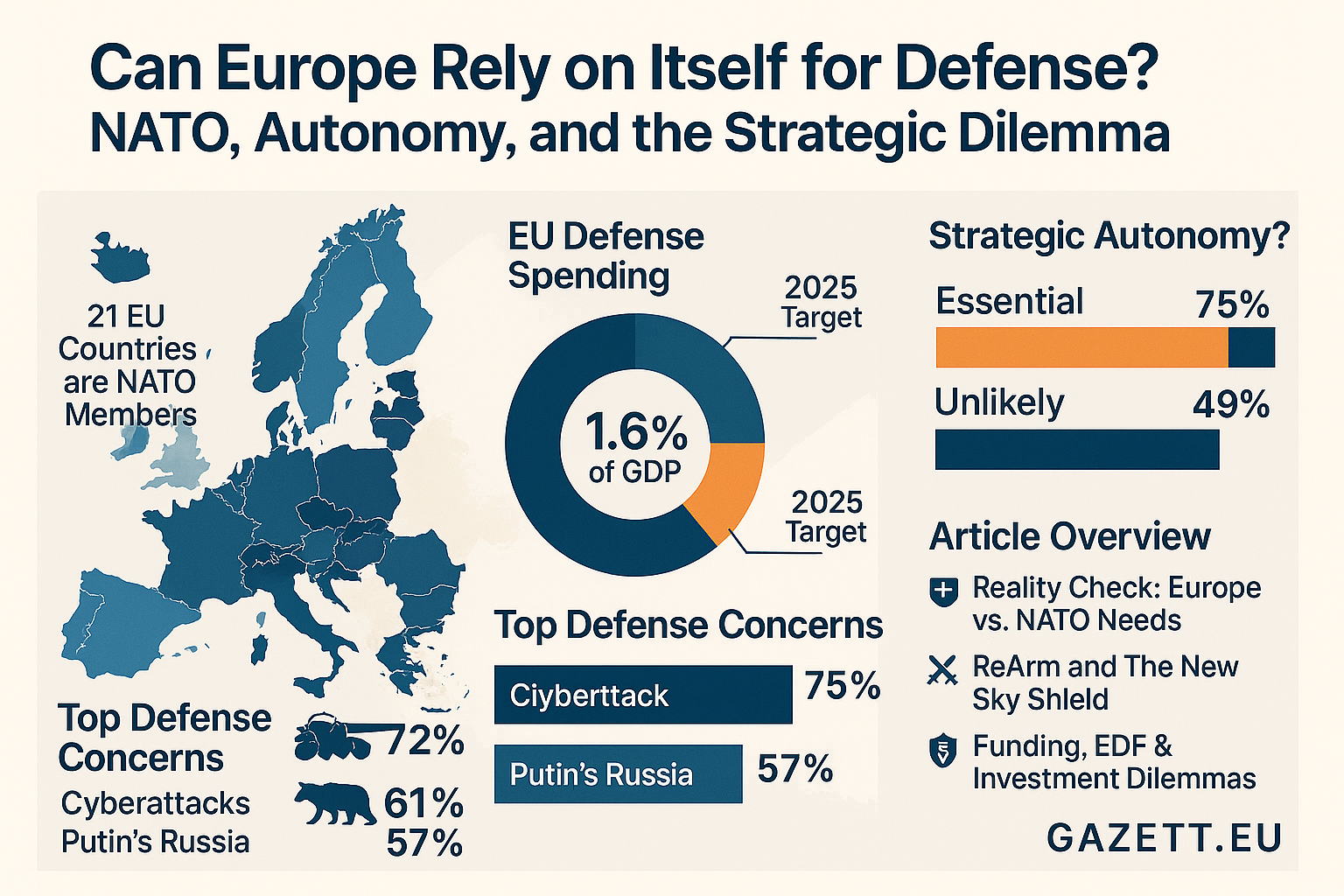
📷 Visual: Europe’s Strategic Autonomy vs NATO Security Umbrella
📚 Article Overview
- ⚔️ America’s Pushback: The End of NATO Dependency?
- 🛠️ Europe’s Strategic Autonomy: ReArm Plan & Sky Shield
- 🧩 Barriers to Unity: Budget, Industry & Political Will
- 🧠 Command Without Consensus? Military Planning Gaps
- 🤖 AI, Drones & Cyber: The Autonomy Tech Stack
- 📊 Defense Reality Check: Who’s Ready, Who’s Lagging?
- 📝 Conclusion: Can Europe Walk the Talk?
⚔️ America’s Pushback – The End of NATO Dependency?
In 2025, the transatlantic alliance faces unprecedented uncertainty. The re-election of Donald Trump and his administration's stance on “fair burden-sharing” has reignited long-standing concerns about U.S. commitment to NATO. Senior American officials, including Rep. Mike Waltz, have publicly stated that “Ukraine’s defense must be European-led” — signaling a shift toward a less interventionist posture from Washington.
With pressure mounting on EU members to reach or exceed the 2% GDP defense target, several countries have accelerated their military budgets. Yet, behind the funding surge lies a deeper question: Can Europe defend itself without U.S. airpower, intelligence, and logistics? NATO still underpins most of the continent’s military deterrence — especially on the eastern flank, from Poland to Romania and the Baltics.
As outlined in our earlier analysis on Europe’s Military Tech Revolution, the continent is investing in next-gen warfare systems. However, strategic autonomy remains a political goal — not yet a battlefield reality.
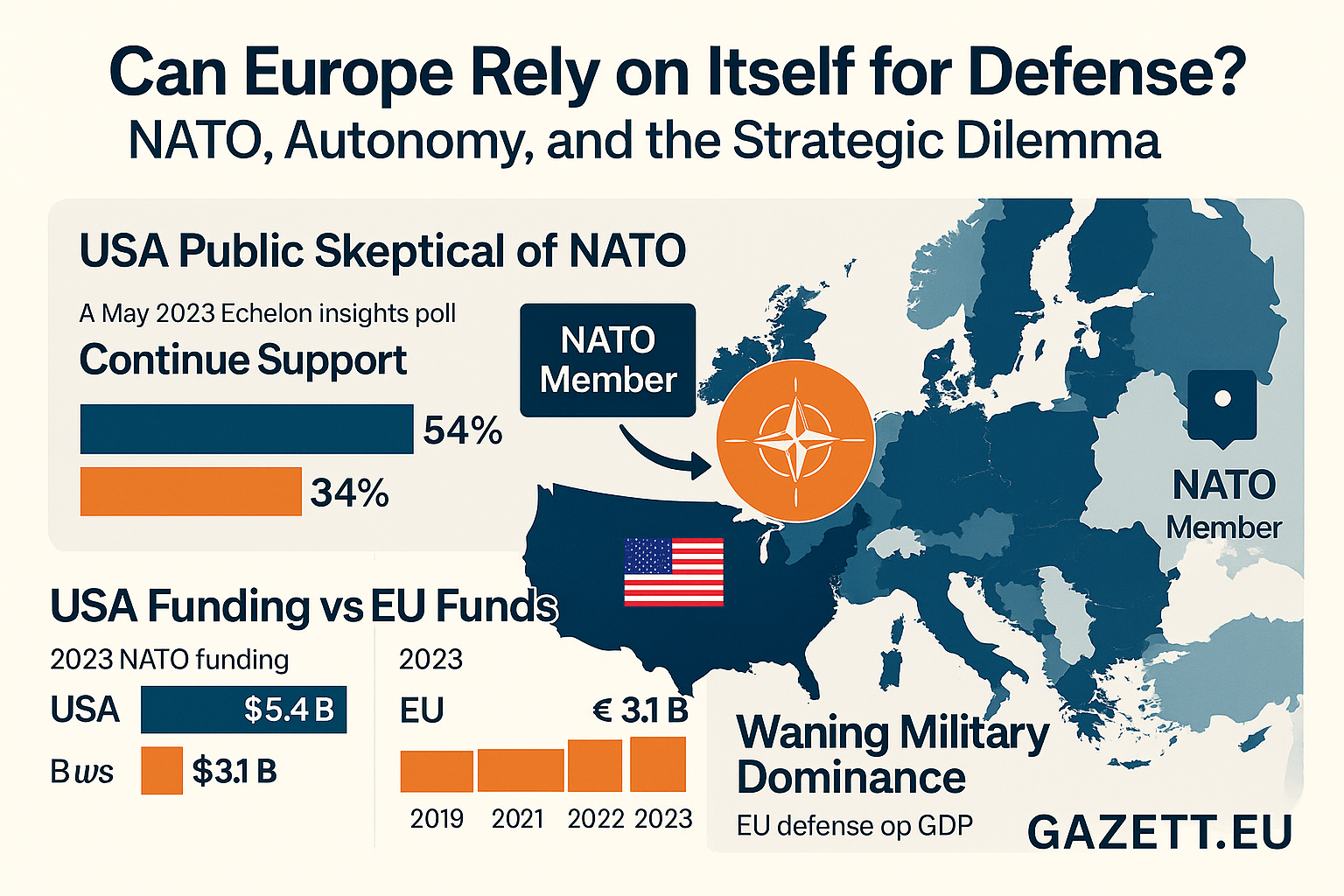
📷 Visual: NATO Dependence vs European Military Autonomy – 2025 Overview
🛠️ Europe’s Strategic Autonomy – ReArm Plan & Sky Shield
Europe’s vision for strategic autonomy is no longer theoretical. With geopolitical shifts intensifying, the EU is mobilizing a record €800 billion under the ReArm Europe Plan — a bold industrial initiative to strengthen defense supply chains, joint procurement, and readiness by 2030.
Complementing this is the European Sky Shield Initiative (ESSI), led by Germany. The program includes 21 EU and NATO countries aiming to build an integrated air defense system to intercept aerial threats ranging from drones to hypersonic missiles. It reflects a shift in mindset: Europe wants to defend its own skies without outsourcing deterrence to the U.S.
These programs mark a turning point. For the first time, EU funding, industrial policy, and military strategy are being aligned. Yet implementation will be the real test — especially as defense remains a jealously guarded national competence among member states.

📷 Visual: ReArm Europe & Sky Shield — Cornerstones of EU Strategic Autonomy
🧩 Barriers to Unity – Budget, Industry & Political Will
Despite bold declarations and billion-euro plans, Europe’s path to military autonomy is obstructed by three critical roadblocks: budgetary constraints, industrial fragmentation, and uneven political commitment across member states.
Many EU economies remain bound by post-COVID fiscal rules and inflation pressures. Defense spending, while increasing, still competes with welfare, climate, and healthcare priorities — particularly in Southern and Eastern Europe. Meanwhile, European arms production is hindered by duplicate platforms and siloed procurement. As Atlantic Council warns, this fragmentation makes Europe less interoperable and less efficient than it should be.
Politically, France, Germany, and Poland have declared support for “more Europe in defense,” but others remain skeptical or strategically tied to U.S. protection. Without a common foreign policy or unified command, EU defense remains aspirational, not operational.
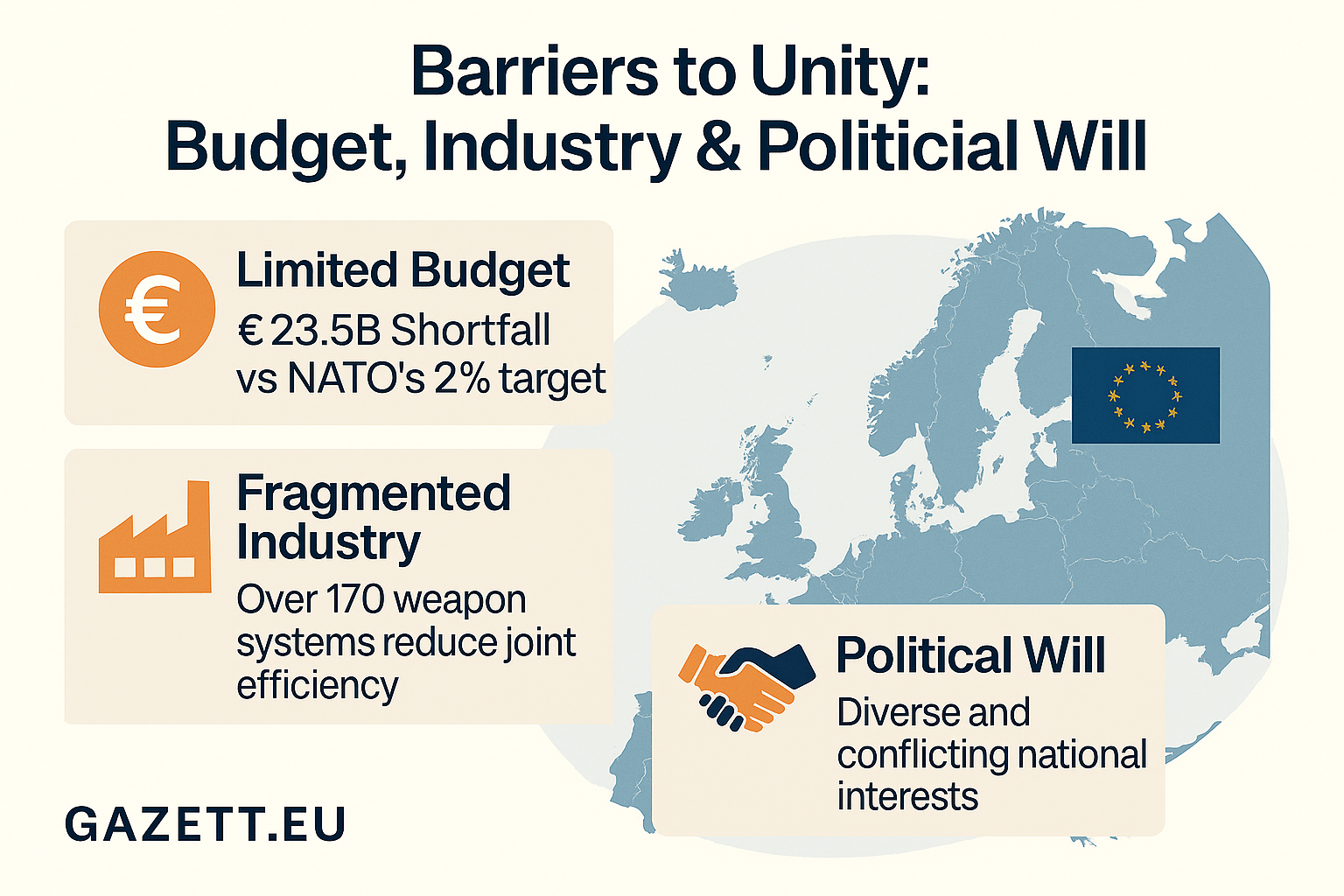
📷 Visual: EU Defense Gaps – Budget, Industry, Political Alignment
🧠 Command Without Consensus – Military Planning Gaps
One of the greatest weaknesses of EU defense ambitions is the lack of a unified military command. Unlike NATO, which benefits from a central structure and joint command doctrine, the EU lacks a permanent chain of command, crisis coordination center, or battlefield-tested joint HQ.
The EU’s Military Planning and Conduct Capability (MPCC) exists, but is under-resourced and limited in operational scope. It cannot lead large-scale missions without NATO integration. Meanwhile, strategic culture varies widely — with France favoring expeditionary action, Germany emphasizing diplomacy, and Nordic states leaning toward hybrid resilience.
As outlined in the European Parliament’s 2025 Defense Capability Report, coordination remains ad hoc. Until Europe resolves this command gap, its strategic autonomy will remain a rhetorical project — not an operational force.
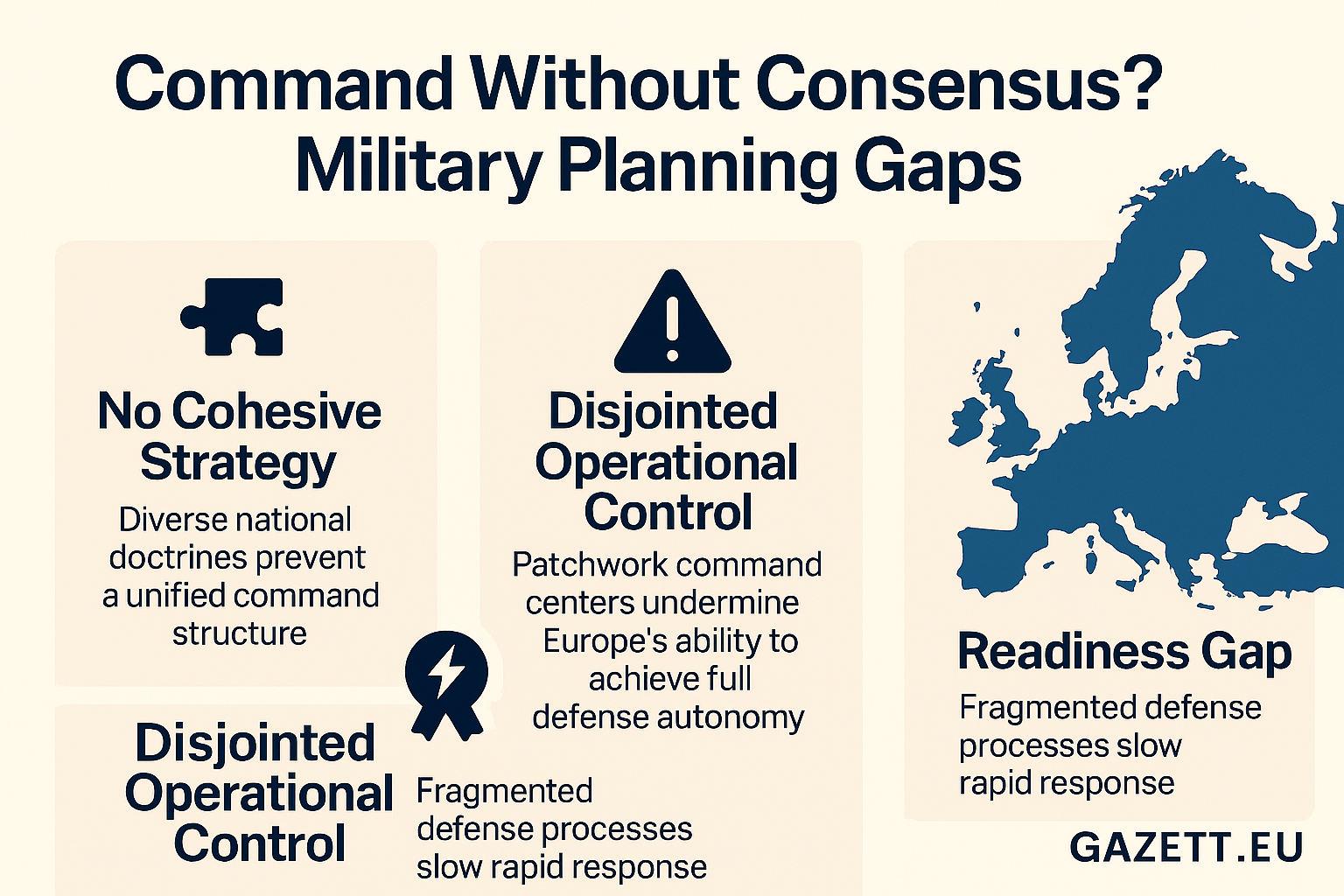
📷 Visual: EU vs NATO – Command Structure & Planning Gaps (2025)
🤖 AI, Drones & Cyber – The Autonomy Tech Stack
As Europe seeks military independence, its technological edge will be a decisive factor. In 2025, the continent is ramping up investments in AI-enabled defense systems, drone warfare, autonomous surveillance, and cyber warfare capabilities — forming what some analysts call the “Autonomy Tech Stack.”
EU-funded programs under the European Defence Fund (EDF) now channel over €1.2 billion into projects such as unmanned aerial systems, real-time battlefield analytics, and quantum-secure communication tools. Countries like France, Estonia, and Finland are also launching public-private partnerships to deploy cyber militias and drone fleets tailored to asymmetric threats.
As covered in our article Europe’s Military Tech Revolution, the battleground of the future is digital-first. But until these tools are operationalized under a shared doctrine, Europe’s AI and cyber arsenal remains high-potential but politically uncoordinated.
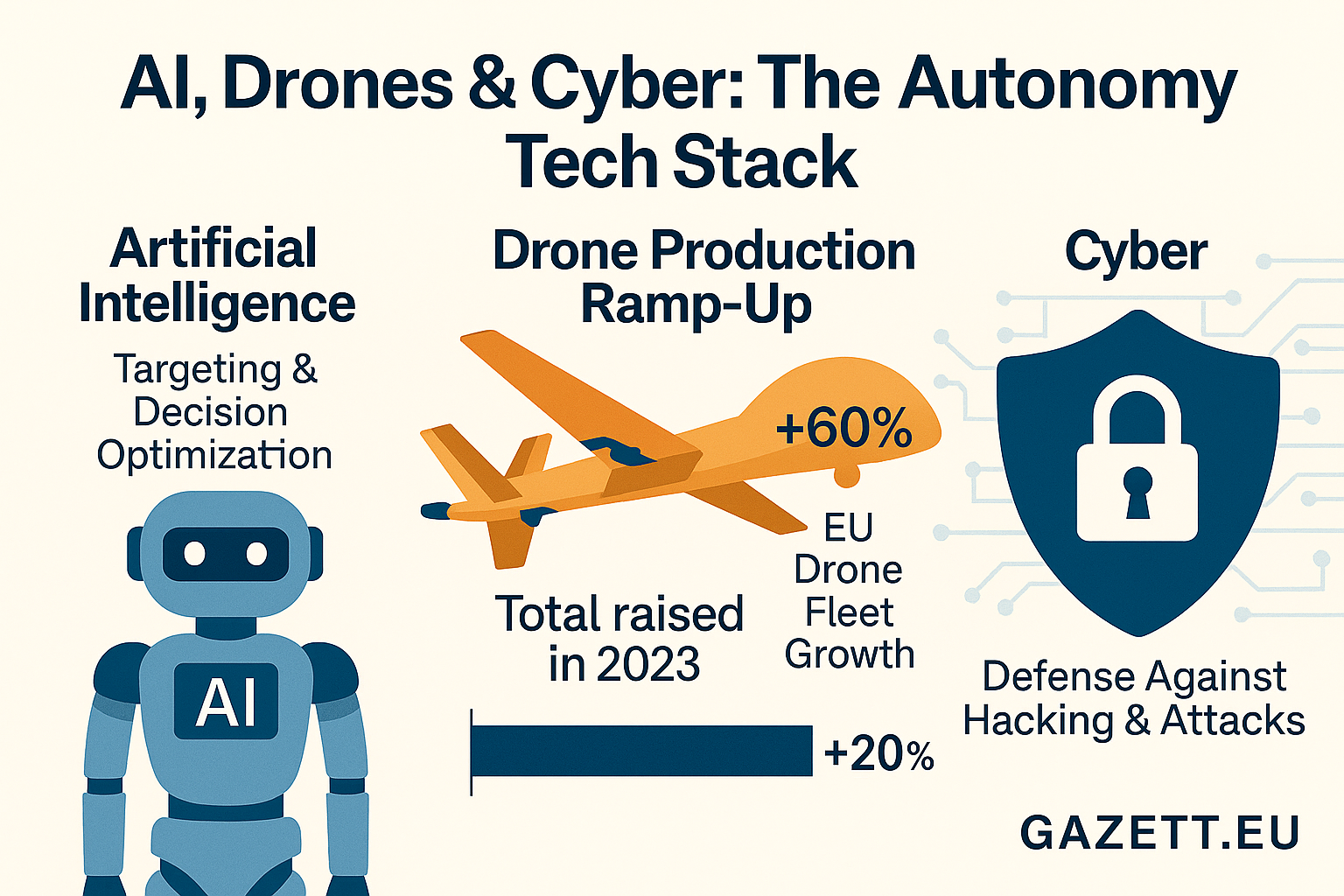
📷 Visual: AI-Enabled Defense Systems, Drones, and Cyber Warfare – Europe 2025
📊 Defense Reality Check – Who’s Ready, Who’s Lagging?
Despite EU-wide ambitions, defense readiness in Europe remains deeply uneven. Countries like Poland, France, and Finland are increasing defense spending, scaling procurement, and restructuring doctrine to reflect modern threats. Poland is now spending over 4% of its GDP on defense — the highest in the EU.
In contrast, several Southern and Western nations are falling short of NATO targets, delaying critical upgrades in air defense, logistics, and cyber resilience. Smaller nations often rely on joint EU procurement programs but lack domestic industrial depth. Even Germany — despite its €100B Zeitenwende fund — has faced delivery lags and procurement bottlenecks.
Strategic autonomy will only be credible if Europe’s defense capacity is both distributed and interoperable. Below is a snapshot of which countries are leading — and where gaps still persist.
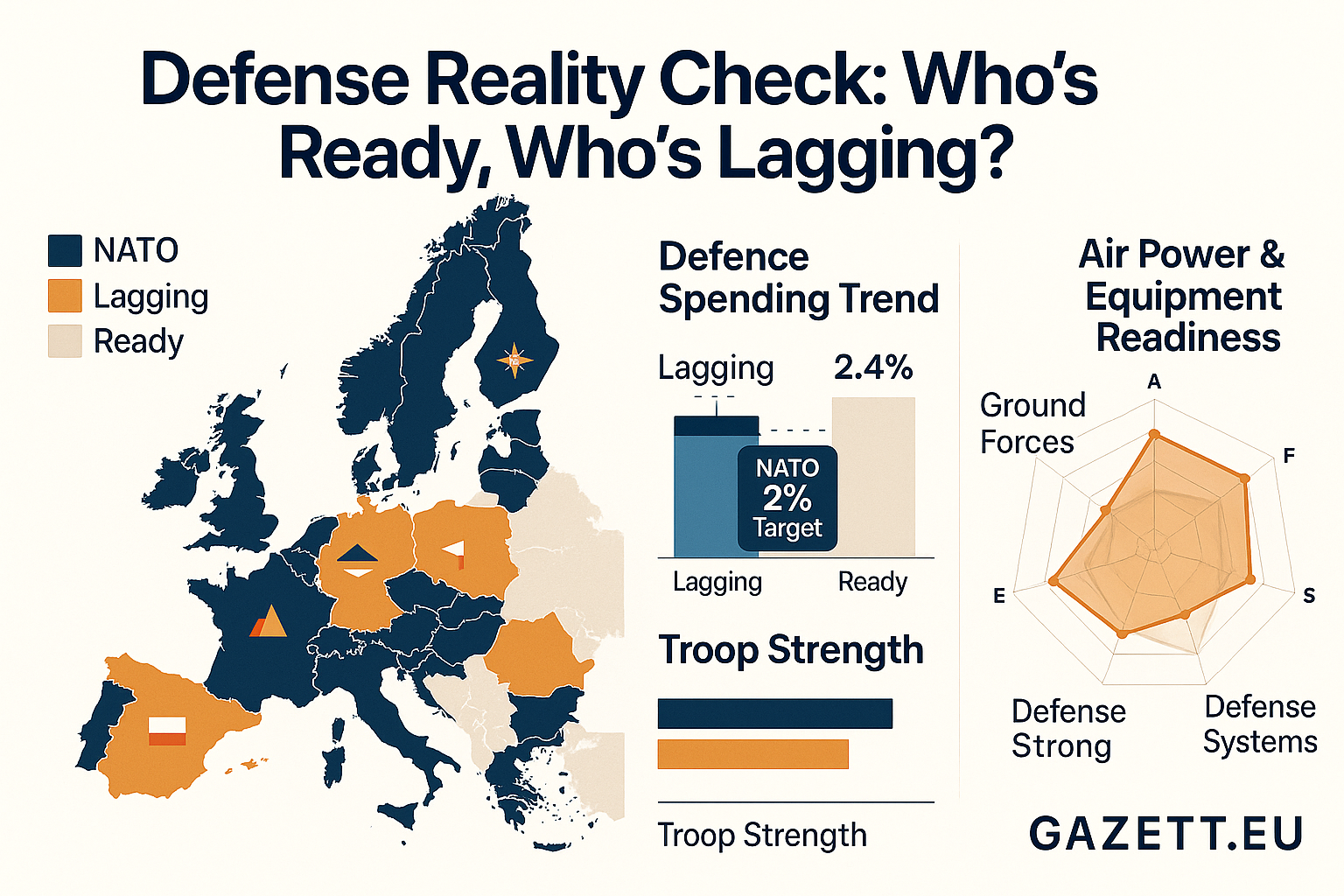
📷 Visual: Defense Readiness Scorecard – Europe’s Top & Lagging Military Performers (2025)
📝 Conclusion – Can Europe Walk the Talk?
Europe stands at a critical defense crossroads in 2025. It is clear that strategic autonomy is no longer optional — but essential. As the U.S. redefines its global posture and security guarantees become less predictable, the European Union must move from policy ambition to battlefield credibility.
Initiatives like the ReArm Europe Plan, Sky Shield, and increased EDF funding show real momentum. Yet without a unified command, synchronized investment, and common threat perception, Europe risks becoming a fragmented security player — strong in rhetoric, weak in response.
The coming years will decide whether Europe remains a strategic protectorate or evolves into a self-reliant defense power. In the end, the real question isn’t “Can Europe rely on itself?” — but “Will Europe choose to?”
Sources: EU Defence Industry Portal, NATO.int, Associated Press, Atlantic Council, European Parliament Studies